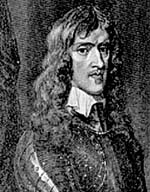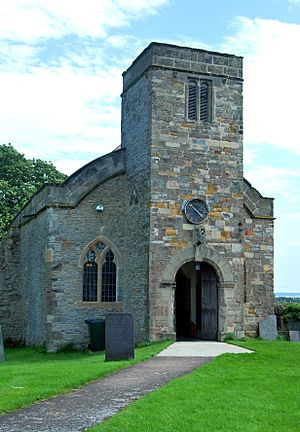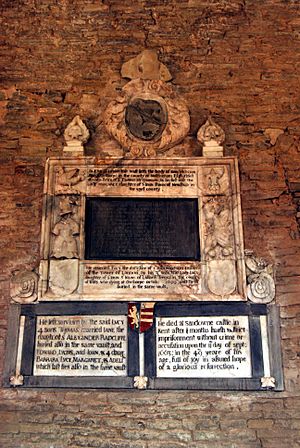John Hutchinson (Roundhead) facts for kids
Quick facts for kids
John Hutchinson
|
|
|---|---|

Colonel John Hutchinson
|
|
| Member of the House of Commons of England | |
| In office 1648 – 1653, briefly in 1660 |
|
| Governor of Nottingham Castle and Town | |
| Assumed office 29 June 1643 |
|
| Commissioner for Exclusion from Sacrament in 1646 and Commissioner for Scandalous Offences in 1648 | |
| Personal details | |
| Born | September 18, 1615 Owthorpe Hall, Nottinghamshire |
| Died | September 11, 1664 (aged 48) Sandown Castle, Kent |
| Cause of death | Fever |
| Nationality | English |
| Spouse | |
| Children | 9, including John and Barbara |
| Parents | Thomas Hutchinson and Margaret Byron |
| Relatives | Sir John Byron (Maternal Grandfather) |
| Education |
|
| Occupation |
|
| Military service | |
| Allegiance |
|
| Branch/service | |
| Years of service | English Civil War Period |
| Rank | Colonel |
| Battles/wars | English Civil War |
Colonel John Hutchinson (1615–1664) was an important English politician and military leader. He lived during the time of the English Civil War, a major conflict in England's history. He served in the House of Commons of England as a Member of Parliament (MP) from 1648 to 1653, and again briefly in 1660.
Hutchinson was a strong supporter of the Puritan movement and fought for the Parliament's army, known as the Roundheads. In 1649, he was one of the 59 people who signed the death warrant for King Charles I. After the king's son, Charles II, returned to power (this was called the Restoration), John Hutchinson was not allowed to hold public office. He was later accused of being involved in a plot in 1663 and was put in prison, where he sadly died.
He was also very good at buying paintings from King Charles I's art collection after the king's execution. He spent a lot of money but then sold the paintings for a big profit a few years later.
Contents
Life of John Hutchinson
Early Years and Education
John Hutchinson was born to Thomas Hutchinson and Margaret Byron. His father, Thomas, owned a place called Owthorpe Hall. John's mother, Margaret, was the daughter of Sir John Byron.
John was baptised on September 18, 1615. He went to Nottingham Grammar School and then Lincoln Grammar School. He didn't like the headmaster at Lincoln, calling him 'a supercilious pedant' (meaning someone who was too strict and showed off their knowledge). Later, he studied at Peterhouse, Cambridge, a famous university. In 1636, he started studying law at Lincoln's Inn, but he soon became more interested in music and religious studies.
Joining the Parliament's Side
Unlike his father, who supported the King, John Hutchinson chose to support the Parliament. He first showed his bravery by stopping Lord Newark, a royal official, from taking the county's gunpowder for the King.
He then became a lieutenant-colonel in a regiment (a military unit) and joined the parliamentary committee for Nottinghamshire.
Governor of Nottingham
On June 29, 1643, John Hutchinson was given command of Nottingham Castle. In November, he was asked to raise his own regiment of soldiers. Finally, Parliament made him the governor of both Nottingham town and the castle.
This was a tough job because the town wasn't well protected, and his soldiers were few and didn't have enough supplies. Also, the local committee helping him was often arguing.
The Royalist commanders nearby, including his cousin Sir Richard Byron, tried to bribe Hutchinson. They offered him a lot of money and promised to make him "the best lord in Nottinghamshire." But Hutchinson bravely refused all their offers.
The town was often attacked by Royalist forces. Hutchinson always managed to fix any damage and refused to surrender, even when asked many times. He also had to deal with constant arguments with the local committee.
Serving in Parliament
On March 16, 1646, Hutchinson became a Member of Parliament for Nottinghamshire, taking over the seat his father had held. He was part of the Independent religious group, rather than the Presbyterian group. As governor, he had protected religious groups who were not part of the main church. He also became a commissioner for religious matters.
The King's Trial
On December 22, 1648, Hutchinson signed a protest against Parliament's agreement with the King. He then agreed to be one of the judges at the trial of Charles I. His wife wrote that he didn't want the job, but he felt it was his duty. After much thought and prayer, he signed the document that sentenced the King to death.
Life After the War
From 1649 to 1651, John Hutchinson was a member of the first two Councils of State for the new government, called the Commonwealth. However, he didn't play a very active role. In 1653, he moved back to his family home at Owthorpe and lived quietly until 1659, when he became the High Sheriff of Nottinghamshire.
His wife, Lucy Hutchinson, wrote that Oliver Cromwell, who became England's leader, tried to get her husband to work for him. But John Hutchinson refused because he didn't agree with Cromwell's rule.
The Restoration and Imprisonment
When King Charles II returned to power in 1660 (the Restoration), Hutchinson was allowed to keep his life and property, but he was removed from Parliament and could no longer hold any public office. He admitted that he had been involved in a "horrid crime" (referring to the King's execution) but said he truly regretted it. Thanks to his apology and the help of his relatives, he avoided the harsh punishments given to many other people who had signed the King's death warrant.
In October 1663, Hutchinson was arrested because he was suspected of being involved in a plot called the Farnley Wood Plot. Even though the evidence against him wasn't strong, the government wanted to imprison him.
Being in prison actually made Hutchinson feel more at peace. He felt it freed him from any promises he had made to the government. While he was held in the Tower of London, he was treated very badly. He even managed to get a story of his arrest and treatment printed to let his family and friends know he was innocent.
In April 1664, he was supposed to be sent to the Isle of Man, but instead, he was moved to Sandown Castle, Kent on May 3, 1664. This castle was old, falling apart, and unhealthy. He caught a fever and died there just four months later, on September 11, 1664. His wife was allowed to bury him at St Margaret's Church, Owthorpe.
What People Thought of Him
The historian C. H. Firth believed that John Hutchinson's defense of Nottingham was very important for the Parliament's cause. However, his later political career didn't show much skill. His fame mostly comes from the detailed biography written by his wife, Lucy Hutchinson, which described his life and character.
Family Life
John Hutchinson was married to Lucy Apsley. Lucy was the daughter of Sir Allen Apsley, who was the Lord Lieutenant of the Tower of London. John and Lucy had nine children together, including two named John and Barbara.
His wife, Lucy, wrote a famous book about his life called Memoirs of the life of colonel Hutchinson. Even though the book was published after she died, she had known many of the people involved in the English Civil War. This made her the perfect person to write about the events of that time.



